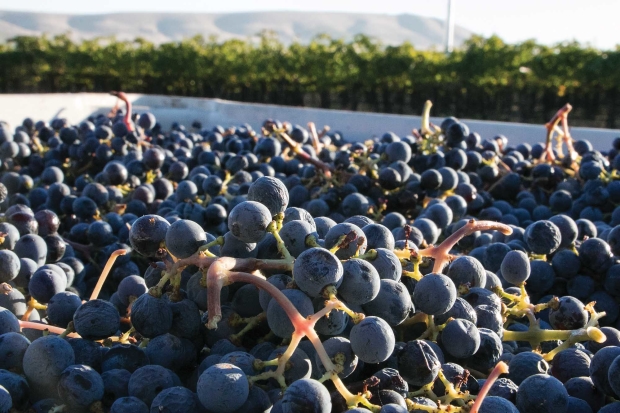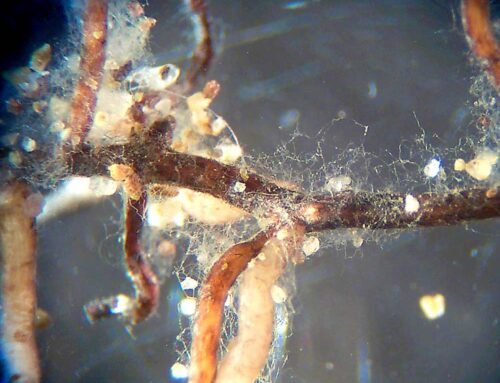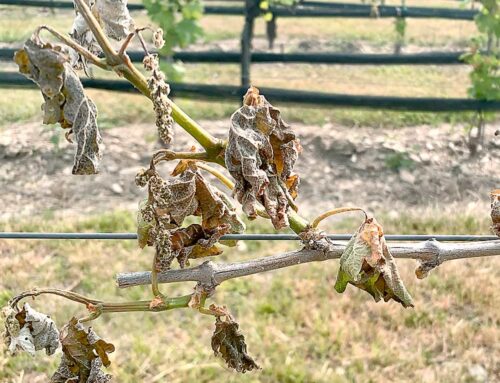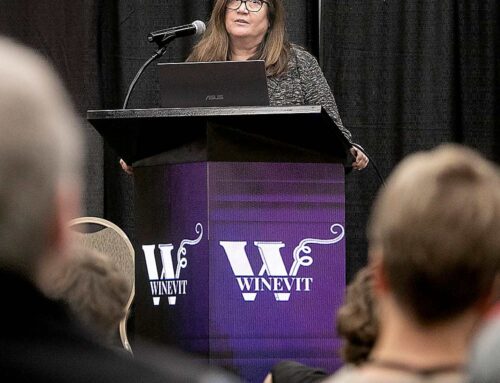
Cabernet Sauvignon grapes are harvested at Klipsun Vineyards in the Red Mountain AVA near Benton City, Washington on October 10, 2014. (TJ Mullinax/Good Fruit Grower)
Tannins, which are an essential component of fine wines, require a team effort by grower and winemaker, but are ultimately managed in the winery.
Related Story
They are especially important in red wine because they add structure, texture, and flavor complexity, help in long-term aging, and can help extend a wine’s finish.
Too much tannin makes wines overly astringent and adds to the time needed for aging; too little results in flabby wines with little structure that are not age worthy.
The complex topic of tannins—how they can be impacted in the vineyard, managed in the winery, and communicated with wine trade and consumers—was discussed by viticulturists and vineyard managers, research enologists and winemakers, and wine marketers during a meeting of the Washington Association of Wine Grape Growers.
Tannins are primarily located in the outer layer of the grape berry seed coating and outer layer of skin as well as in stems and pedicels. They are made from flavan-3-ol phenolics and serve as a defense mechanism for the vine.
The bitter skin and seeds are thought to deter would-be fruit thieves, like birds and mammals, although some growers still have bird problems.
Tannins bind to and precipitate proteins, such as those in saliva. That’s why when you eat something astringent, your saliva changes from a slippery feel to dry and chalky.
In the vineyard
Dr. Markus Keller, Washington State University viticulturist, says seed tannins develop in the berry during fruit set to veraison and the early ripening stage, while skin tannins accumulate in the fruit from pre-bloom to before veraison.
“There are cultural practices that can fine-tune what nature imposes,” Keller said, and noted that low shoot vigor can increase skin tannins and anthocyanins.
Sun exposure can also increase skin tannins and anthocyanins, though he cautioned growers to be aware of excessive heat that can sunburn exposed clusters.
Water deficits, such as regulated deficit irrigation regimes, can increase skin tannins and anthocyanins, mostly due to lower vigor, greater fruit exposure, and smaller berries. Skin and seed tannins and anthocyanins also can be increased in grape berries by imposing a nitrogen deficit.
“Nitrogen deficits help lower vine vigor, allow for greater fruit exposure (smaller canopy), and help stimulate production of phenolics,” Keller said.
Tannins are generally associated with red wines, not white. Keller explained that there are tannins in white grapes—they are mostly the same phenolics in red grapes minus anthocyanins and some flavonols—but the phenolics have been inactivated or silenced much the same way red-haired or fair-skinned people don’t tan. “White grapes still make tannins and some flavonols but they just can’t make (or make few) anthocyanins that give the red color.”
That’s why too much sunlight on white grapes can increase skin flavan-3-ols and tannins to create bitter, astringent-tasting fruit. Keller noted that, generally, white varieties have less need for devigorating trellis systems, leaf removal, and deficit irrigation.
Although tannins are developed on the grower’s watch, for the most part, they are managed during the winemaking process.
In the winery
Dr. James Harbertson, Washington State University extension enologist, said there are many ways tannins can be influenced in the winery, such as duration of maceration. Tannins in grape skins are readily extractable but are more slowly extracted from seeds.
There are also tannins in pulp and stems, though stems are not typically part of the maceration process. Extended macerations extract more seed tannins.
Harbertson cited research with Pinot Noir that showed skin tannin extraction plateaued within nine days, while seed tannin took 17 days to plateau. He noted that extraction times of Pinot Noir might not hold true for all varieties.
Harbertson has studied the evolution of anthocyanins and tannins in wine from zero to 200 days in a tank.
“Once grapes are pressed, there’s not much change in tannins and anthocyanins, and they both peak at about four days,” he reported. “Anthocyanin levels then drop due to the polymer effect of anthocyanins and tannins combining to make new compounds.”
Scientists haven’t yet answered why wines get less tannic as they age. Wines are chemically complex with high and low polymers, chain reactions occurring during aging, and phenolics binding with chemicals to prevent their breakdown.
“I’ve measured wines that are 50 and 60 years old that still have quite a lot of tannins in them,” he said. “It all depends on what you’re doing and what you started with. What you do is going to affect all other things.”
Each winery is unique and winemakers must figure out what they are doing that influences tannin levels. Things like fermentation temperatures, crushing and destemming procedures, adding enzymes, and blending and fining practices are techniques used to manage tannins.
Analyzing phenolics
There are tools available to analyze phenolics in wine, such as the widely used Harbertson-Adams assay, and a model-based assay developed for Hogue Cellars that is similar to the Harbertson-Adams assay but less time consuming.
Corey Beck, president of Francis Coppola Winery in Geyersville, California, said they began using the Harbertson-Adams assay in 2003. Francis Coppola’s Claret red wine, with the distinctive gold netting around the bottle, is the best-selling Cabernet blend in America. Around 310,000 cases are produced annually.
Beck noted that the assay requires significant investment by the winery—it cost around $25,000 to get the lab up and going—and he has a full-time lab staff.
But the in-house testing of phenolics has helped to improve their winemaking decisions, improve grower relations, identify their wine style, and gauge vintage variations. “It’s a great tool to show you what is in your wine,” he said.
“For growers, it serves as a third party if there’s a difference of opinion and helps us give growers more data about their fruit quality,” said Beck. “At the winery, the phenolic assay has helped us define and assess quality and achieve consistency.” •






Leave A Comment